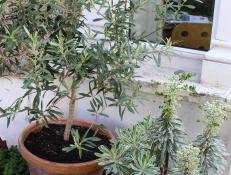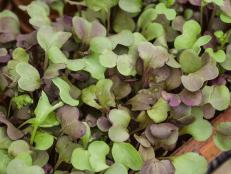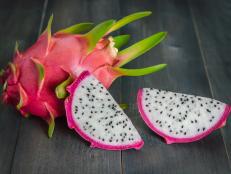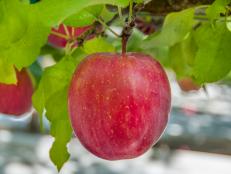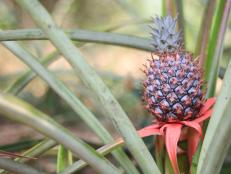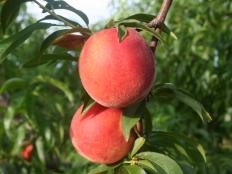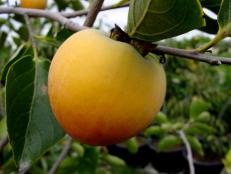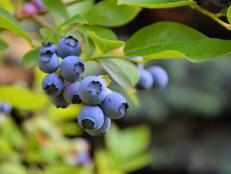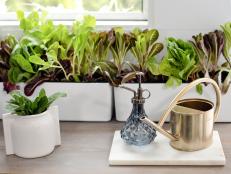Grow a Kaffir Lime Tree Indoors


Aromatic kaffir limes (Citrus hystrix), with their glossy foliage and wrinkled fruits, give many Thai, Indonesian and Cambodian dishes their delicious flavor. The young leaves can be finely shredded for salads, while mature leaves are torn or tossed whole into stir fries, curries, soups and more. From zest to juice, and leaves to rinds, kaffirs add a lemony-spicy taste.
While it's possible to find fresh kaffir limes or dried leaves for sale, it’s fun to grow your own dwarf tree. These members of the citrus family are sometimes sold as Thai or kieffer limes and known botanically as Citrus hystrix.
Dwarf kaffirs, which can grow to 5 feet, will perish in freezing weather. But even if you live where the winters are cold, you can enjoy your tree indoors if you provide the right growing conditions.
Kaffirs need 8 to 12 hours of full sun each day. Few homes offer that much natural light, so try to place your tree in a spot that gets at least 5 to 6 hours of direct sun a day (a south or southwest window is ideal), and supplement that with full spectrum or fluorescent plant lights. (Plants need regular periods of light and darkness, however, so don’t run the lights all the time.)
If your tree is a 1-year-old plant, start it out in a 6- to 9-inch container. Two to 3-year-old trees can go into 12- to 14-inch pots. Use a container with drainage holes, or drill some in the bottom, and choose a potting mix that drains easily.
If you can’t find a potting mix made for citrus, use an outdoor mix rather than ordinary garden soil or one formulated for houseplants. Houseplant mixes hold water and keep citrus roots too wet. Some gardeners prefer to make their own mix by combining two parts of cedar shavings to one part compost and one part sand.
When you're ready to plant, ease the tree out of its pot and gently untangle the roots. If you have a bare root tree, shake off the shavings it came in and combine them with the potting mix.
Put your tree into the potting mix, keeping the root collar (the crown roots) above the soil. The top of the roots should be slightly below the soil’s surface. Gently firm the soil and stake the tree if needed. Make sure your ties will stretch so they won’t cut into the tree as it grows.
Give your kaffir lime a spot with good air circulation, but avoid drafts from heating and cooling vents.
Watering once a week is usually enough. The soil should stay moist, not soggy. Don’t water just because the soil surface looks dry. Use a moisture meter or a sharpened, wooden dowel stuck into the soil at various depths to see if it's dry further down, closer to the roots. Too much water can be fatal.
It’s also a good idea to use pot feet or bricks to hold your potted kaffir above any saucer you have beneath it. If it stands in the drainage water, the roots can rot.
Since the air in most homes is too dry for citrus, increase the moisture by misting your lime with water or use a small humidifier. It also helps to group houseplants together or to grow them in a humid bathroom or kitchen.
Citrus trees need lots of nitrogen, so feed with a citrus fertilizer or slow-release product with a 2-1-1 ratio of nitrogen (N) to phosphorous (P) and potassium (K). Follow label directions on when and how much to apply. A citrus fertilizer is your best bet, because it will contain the trace minerals these trees need: iron, zinc and manganese.
It’s fine to remove any thorns on your dwarf kaffir. They don’t serve any purpose indoors. Prune anytime to keep the tree in shape, especially if branches cross or rub against each other.
Scale and other pests sometimes attack indoor kaffirs. Try spraying them with water mixed with a little dishwashing soap, but if they persist, step up to a commercial horticultural soap or oil made for indoor use.
Once all chance of frost has passed, kaffirs can move outdoors to vacation in the sunshine and fresh air. Just make the move gradual so your tree isn’t shocked by sudden changes in the the temperature and light. Move it into a partially shaded spot for a week or so before giving it direct sun.
Kaffirs are self-pollinating. Harvest the fruits when they turn light yellow and enjoy them—along with the leaves, juice and zest—in your favorite recipes.






